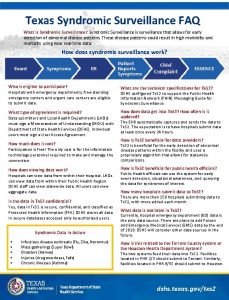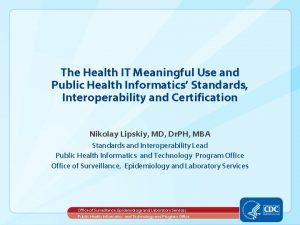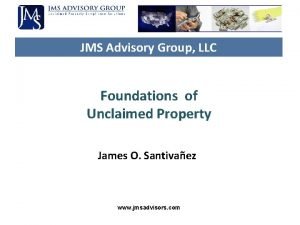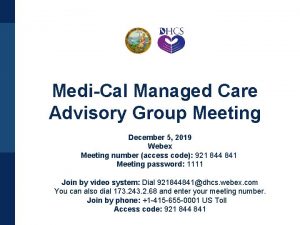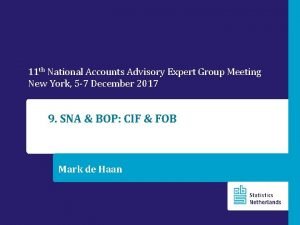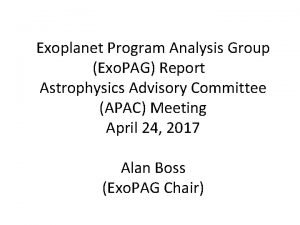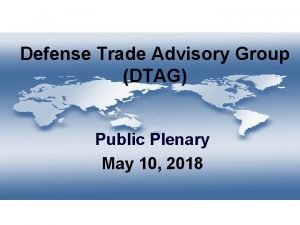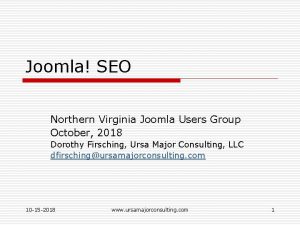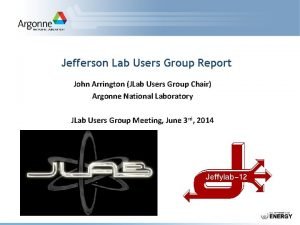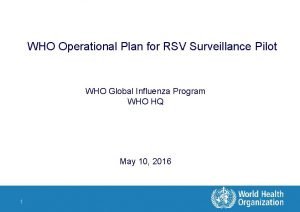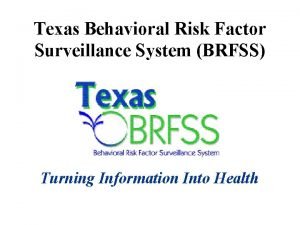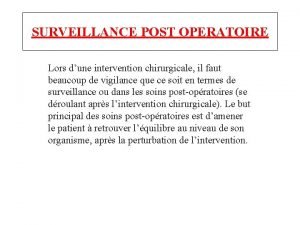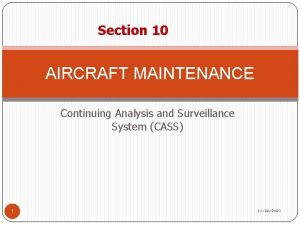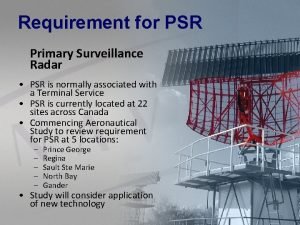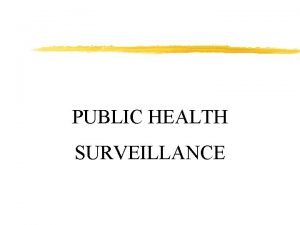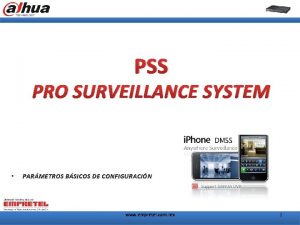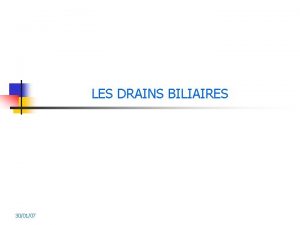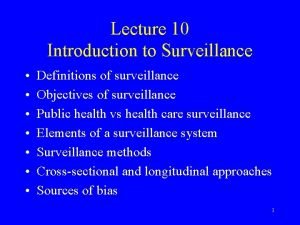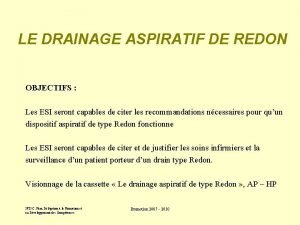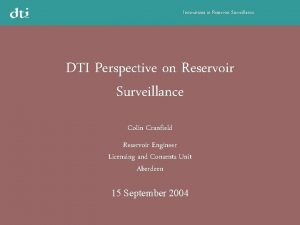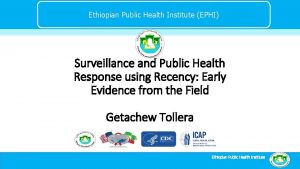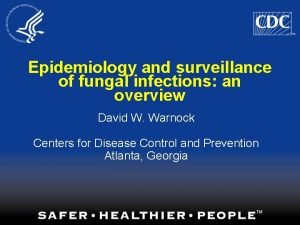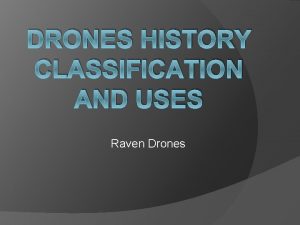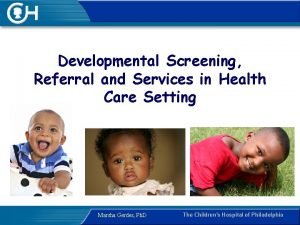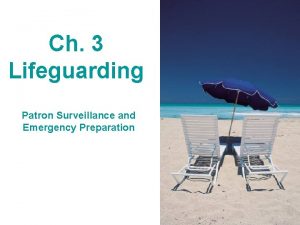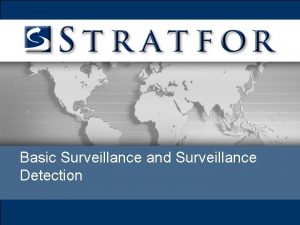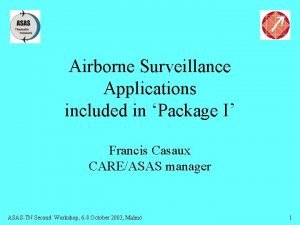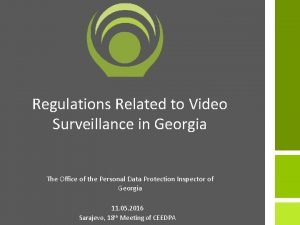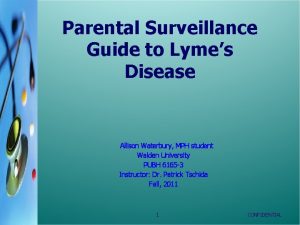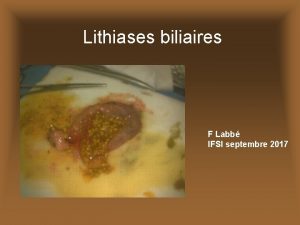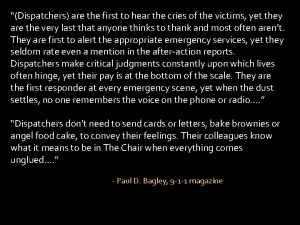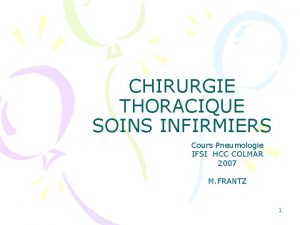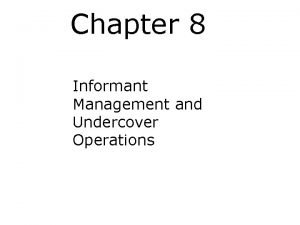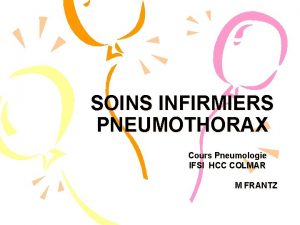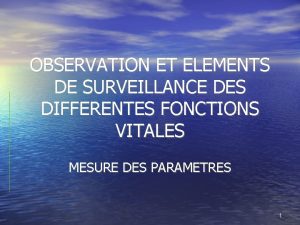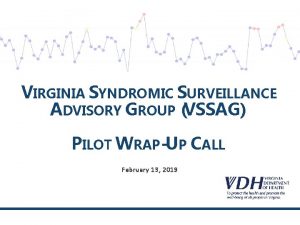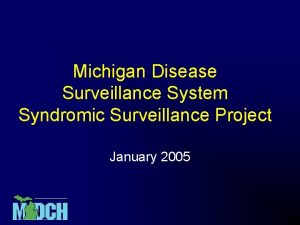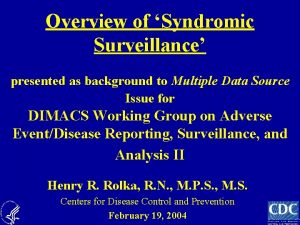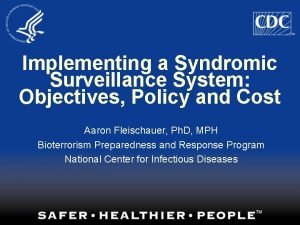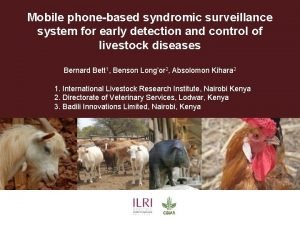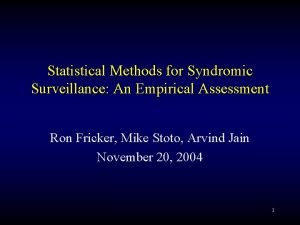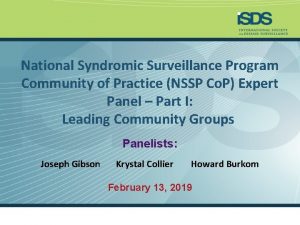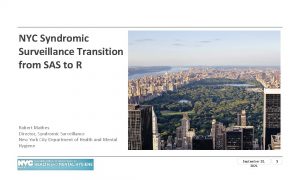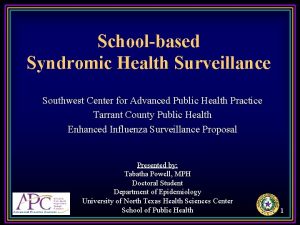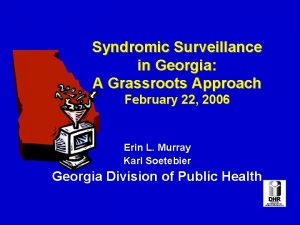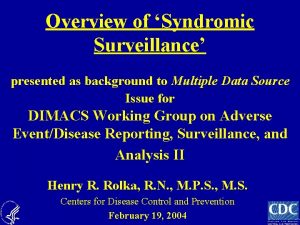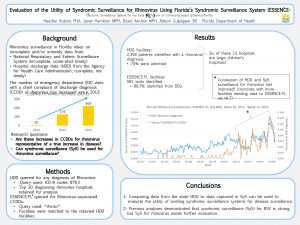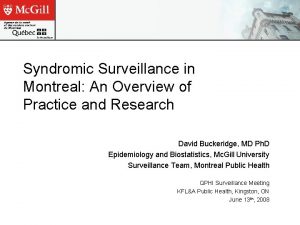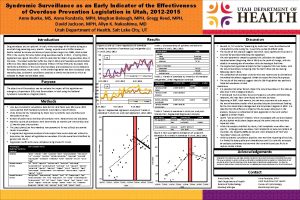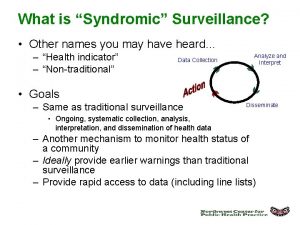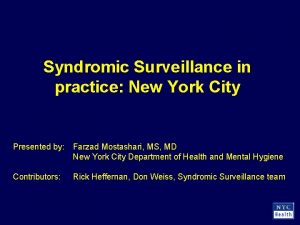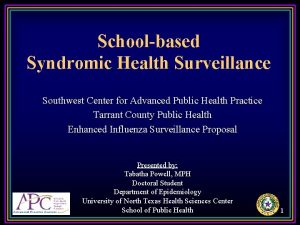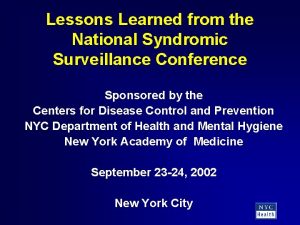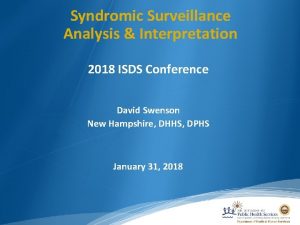VIRGINIA SYNDROMIC SURVEILLANCE ADVISORY GROUP Second Meeting June


















































- Slides: 50

VIRGINIA SYNDROMIC SURVEILLANCE ADVISORY GROUP Second Meeting June 15, 2017 1

Agenda • • • 2 Introductions Pre‐Assessment Survey Responses Syndromic Surveillance Data Elements Surveillance Tool – ESSENCE Break for Lunch Discussion • NSSP User Access Roles • NSSP User Access Forms

Introductions Em Stephens Enhanced Surveillance Analyst Emily. Stephens@vdh. virginia. gov 804‐ 864‐ 7254 3 Erin Austin, MPH Enhanced Surveillance Coordinator Erin. Austin@vdh. virginia. gov 804‐ 864‐ 7548

PRE-ASSESSMENT SURVEY RESPONSES 4

Pre‐Assessment Survey • Plan to conduct survey every year that Virginia Syndromic Surveillance Advisory Group is active • Responses will enable VDH to measure success of group in reaching goals and objectives • Will also help direct further meetings April 2017 • Survey conducted using REDCap online survey tool • Results analyzed using SAS 9. 3 • Identified median response for each category analyzed 5

Goal and Objectives • Goal is to increase understanding and use of syndromic surveillance data 1. Hold regular meetings to facilitate collaboration (minimum two per year) 2. Maintain diverse membership 3. Define a set of protocols for data sharing 4. Provide trainings to improve knowledge 5. Provide NSSP access to those eligible 6. Encourage use of Sy. S data to inform business practices 7. Obtain feedback on Sy. S data and reports 8. Evaluate success of advisory group 6

Survey Reponses Public Safety Healthcare • 17 complete responses out of 39 Emergency Preparedness for 44% response rate • 9 (53%) identify as epidemiologists • 3 (18%) as emergency preparedness • 4 (24%) as healthcare • 1 (6%) as public safety Epidemiology • 15 (88%) respondents attended initial VSSAG meeting 7

Purpose of Syndromic Surveillance • 8 7 (41%) respondents reported considerable experience with understanding the purpose of syndromic surveillance. • Each respondent reported at least limited experience • Respondents identified as epidemiologists were more likely to report considerable or extensive experience • Median: considerable experience Understanding of the purpose of syndromic surveillance Analyzing syndromic surveillance data on a routine basis (e. g. daily, weekly, monthly): Analyzing syndromic surveillance data on a non-routine basis or in response to recent events: Interpreting VDHproduced syndromic surveillance reports (PDF, website): Interpreting VDHproduced syndromic surveillance interactive Tableau dashboards: Extensive 29% 12% 6% 18% 6% Considerable 41% 24% 29% 24% Some 24% 29% 18% 29% Limited 6% 6% 12% 0% 6% None 0% 29% 24% 29% 35%

Routine Analysis • 9 5 (29%) respondents each reported some experience and no experience with routine analysis of syndromic surveillance data. • Median: Some experience Understanding of the purpose of syndromic surveillance Analyzing syndromic surveillance data on a routine basis (e. g. daily, weekly, monthly): Analyzing syndromic surveillance data on a non-routine basis or in response to recent events: Interpreting VDHproduced syndromic surveillance reports (PDF, website): Interpreting VDHproduced syndromic surveillance interactive Tableau dashboards: Extensive 29% 12% 6% 18% 6% Considerable 41% 24% 29% 24% Some 24% 29% 18% 29% Limited 6% 6% 12% 0% 6% None 0% 29% 24% 29% 35%

Non‐Routine Analysis • 10 5 (29%) respondents each reported considerable experience or some experience analyzing syndromic surveillance data on a non‐routine basis or in response to recent events. • Median: Some experience Understanding of the purpose of syndromic surveillance Analyzing syndromic surveillance data on a routine basis (e. g. daily, weekly, monthly): Analyzing syndromic surveillance data on a non-routine basis or in response to recent events: Interpreting VDHproduced syndromic surveillance reports (PDF, website): Interpreting VDHproduced syndromic surveillance interactive Tableau dashboards: Extensive 29% 12% 6% 18% 6% Considerable 41% 24% 29% 24% Some 24% 29% 18% 29% Limited 6% 6% 12% 0% 6% None 0% 29% 24% 29% 35%

Interpreting Reports • 5 (29%) respondents each reported considerable experience or no experience interpreting VDH‐produced syndromic surveillance reports. • Tied for most common response, resulting in a median response between the two levels. • Median: Some experience 11 Understanding of the purpose of syndromic surveillance Analyzing syndromic surveillance data on a routine basis (e. g. daily, weekly, monthly): Analyzing syndromic surveillance data on a non-routine basis or in response to recent events: Interpreting VDHproduced syndromic surveillance reports (PDF, website): Interpreting VDHproduced syndromic surveillance interactive Tableau dashboards: Extensive 29% 12% 6% 18% 6% Considerable 41% 24% 29% 24% Some 24% 29% 18% 29% Limited 6% 6% 12% 0% 6% None 0% 29% 24% 29% 35%

Interpreting Tableau • 12 6 (35%) respondents reported no experience interpreting VDH‐produced syndromic surveillance interactive Tableau dashboards. • Median: Some experience Understanding of the purpose of syndromic surveillance Analyzing syndromic surveillance data on a routine basis (e. g. daily, weekly, monthly): Analyzing syndromic surveillance data on a non-routine basis or in response to recent events: Interpreting VDHproduced syndromic surveillance reports (PDF, website): Interpreting VDHproduced syndromic surveillance interactive Tableau dashboards: Extensive 29% 12% 6% 18% 6% Considerable 41% 24% 29% 24% Some 24% 29% 18% 29% Limited 6% 6% 12% 0% 6% None 0% 29% 24% 29% 35%

Using ESSENCE • 13 6 (35%) respondents reported considerable experience using syndromic surveillance tool ESSENCE for data analysis. • 5 (29%) have no experience • Median: Some experience Using the syndromic surveillance tool ESSENCE for data analysis: Comparing or integrating syndromic surveillance data with other data sources: Communicating or sharing syndromic surveillance information within your organization: Communicating or sharing syndromic surveillance information with your outside partners: Extensive 6% 6% 18% 12% Considerable 35% 12% 18% Some 18% 35% 41% 35% Limited 12% 6% 12% 18% None 29% 18% 18%

Data Source Integration • 14 6 (35%) respondents each reported considerable experience or some experience comparing or integrating syndromic surveillance data with other data sources. • Median: Some experience Using the syndromic surveillance tool ESSENCE for data analysis: Comparing or integrating syndromic surveillance data with other data sources: Communicating or sharing syndromic surveillance information within your organization: Communicating or sharing syndromic surveillance information with your outside partners: Extensive 6% 6% 18% 12% Considerable 35% 12% 18% Some 18% 35% 41% 35% Limited 12% 6% 12% 18% None 29% 18% 18%

Internal Communication • 15 7 (41%) respondents reported some experience with communicating or sharing syndromic surveillance information within organization. • Median: Some experience Using the syndromic surveillance tool ESSENCE for data analysis: Comparing or integrating syndromic surveillance data with other data sources: Communicating or sharing syndromic surveillance information within your organization: Communicating or sharing syndromic surveillance information with your outside partners: Extensive 6% 6% 18% 12% Considerable 35% 12% 18% Some 18% 35% 41% 35% Limited 12% 6% 12% 18% None 29% 18% 18%

External Communication • 16 6 (35%) respondents reported some experience with communicating or sharing syndromic surveillance information with outside partners. • Median: Some experience Using the syndromic surveillance tool ESSENCE for data analysis: Comparing or integrating syndromic surveillance data with other data sources: Communicating or sharing syndromic surveillance information within your organization: Communicating or sharing syndromic surveillance information with your outside partners: Extensive 6% 6% 18% 12% Considerable 35% 12% 18% Some 18% 35% 41% 35% Limited 12% 6% 12% 18% None 29% 18% 18%

ESSENCE Access • 5 (29%) respondents have been granted access to the Virginia version of ESSENCE • 2 (12%) respondents have been granted access to the NSSP version of ESSENCE Virginia ESSENCE Access No Access 17 NSSP ESSENCE Access No Access

Data Use • During the past year (since April 2016), survey respondents have used syndromic surveillance data for the following purposes: Routine business practices Non-routine Justification business for business practices or in decisions response to recent events Collaboration or information sharing within your organization Collaboration or information sharing external to you organization Research 41% 47% 61% 53% 18% • Could select all reasons that applied 18

Comments • How can infection preventionists use chief complaint data more effectively to identify potential reportable diseases or visits of concern? • I’m interested in how these data can be used to monitor emerging problems and how they might be used for decision-making or planning purposes (i. e. , by establishing baselines, triggers for action). • I would love to have additional training on using the ESSENCE system. We have had many updates and new versions of ESSENCE but little training on how to best utilize it in our daily work practices. I am aware of the tutorial videos available but have not had time to utilize these yet. I assume they will support efforts to navigate the updated system. • I think this taskforce would benefit from participation of healthcare systems IT rep. 19

Summary • Survey helped identify some knowledge gaps in data analysis, Tableau interpretation, ESSENCE use and access, and external communication • Focus for future VSSAG meetings • Hope to improve median level of experience, number of ESSENCE users, and rates of use within the past year • We know that not every measure is applicable to every VSSAG member 20

SYNDROMIC SURVEILLANCE DATA ELEMENTS 21

Data Standards • Determines how the data submitted to VDH must be formatted • VDH currently accepts 2 standards • Flat file • Health Level 7 (HL 7) • Both standards are required to be submitted electronically 22

Data Standards – Flat File • VDH specific‐standard established in 2004 • 14 fields with basic facility, patient, and visit info • Data fields generally populated with free‐text – no standardized codes for diagnoses or discharges • One message per visit – “flat file” • Aggregated data file (“batch”) sent every 24 hours • 31 out of 156 (20%) facilities in Virginia still use this format 23

Data Standards – HL 7 • National standard established in 2011 with some VDH‐specific modifications • Requires additional data elements be sent • Requires standardized coded values be used (diagnosis, discharge, race, ethnicity) • More than one message per visit ‐ Supports near real‐time surveillance as first message can be received while patient still in ED ‐ Allows visits details to be sent as they become available (i. e. coded diagnosis information after medical billing) • Received in real‐time or 6‐hour batch file (rare) • 125 out of 156 (80%) facilities in Virginia use this format 24

Data Standards – HL 7 • Adherence to national HL 7 standard is required by electronic health record incentive program (Meaningful Use) • Standardizes how data are captured and reported across jurisdictions • Allows for comparison of data in national CDC’s National Syndromic Surveillance Program (NSSP) ESSENCE system 25

Data Reporting Frequency • Data received by VDH within 24 hours of visit • Data sent from VDH to CDC within 6 hours of receipt • Data processing into ESSENCE at CDC takes approximately 1 day • Available within ~2 days of visit event Visit occurs at Facility A at 6: 00 am on 6/15/17 26 Message is sent to VDH in batch file (all visits on 6/15/17) at 6: 00 am on 6/16/17 Message sent by VDH to CDC at 12: 00 pm on 6/16/17 Visit available in ESSENCE at ~12: 00 pm on 6/17/17

Data Elements • • 27 Facility Information • Facility Name/Campus • Facility Type • Facility Location Demographics • Patient Identifier (MRN, MPI) • Date of Birth • Sex • Race/Ethnicity ‐ Not always available • Residential Zip Code • Visit Information • Chief complaint (CC) • Discharge Diagnosis (DD) ‐ Not always available • Visit Date/Time • Visit Number • Discharge Disposition • Patient Class

Facility Information • Facility Name or Campus Name • Facility Type • Emergency Department • Urgent Care • Facility Location • Assigned by syndromic surveillance staff • Geo‐located for mapping capabilities 28

Patient Information • Patient Identifier • Medical Record Number, Master Patient Index, etc. • Unique to patient, not unique to visit • Identifier provided is determined by facility submitting data 29

Patient Demographics • Date of Birth • Age calculated from DOB • Sex • Race and Ethnicity • Not available for all visits ‐ 23% of 2016 visits missing one or both fields • Available race and ethnicity options found on Public Health Information Network Vocabulary Access and Distribution System (PHIN VADS) • Residential Zip Code • Residential FIPS Code coming soon 30

Visit Information ‐ Chief Complaint • Chief complaint (CC) is the patient‐stated or registration staff‐interpreted reason for seeking care • Ideally non‐standardized free‐text field ‐ Some facilities only able to provide drop‐down options • Can be captured in‐person or via registration kiosk • Generally non‐specific and based on symptoms • Available to VDH within 24 hours 31

Visit Information – Discharge Diagnosis • Coded discharge diagnoses (DD) available after visit occurs • VDH receives diagnosis information anywhere from hours to weeks after visit • Can include multiple diagnoses ‐ Some facilities send coded underlying conditions • Coded in International Classification of Diseases (ICD) – 9 th or 10 th edition • Not available on all visits ‐ 29% of 2016 visits missing diagnosis information • More specific than CC but less flexible than free text 32

Visit Information • Visit Date/Time • Visit Number • Discharge Disposition • Where a patient is sent after ED visit (routine discharge to home, admitted as inpatient, transferred to another hospital, etc. ) • Patient Class • Indicates emergency, inpatient, outpatient visit type 33

Future Data Elements • VDH is currently exploring ability to accept additional data elements in future • Height, weight, pregnancy status, travel history, and others • We will keep you updated as more information becomes available 34

SURVEILLANCE TOOL - ESSENCE 35

ESSENCE Overview • Electronic Surveillance System for the Early Notification of Community‐based Epidemics • Made available to public health and partners through National Syndromic Surveillance Program (NSSP) • Tool that assists with analysis and visualization of syndromic surveillance data • Allows users to: • Conduct epidemiologic and data analyses • Monitor trends over time, geography, and across multiple data sources • Identify issues affecting the public’s health 36

ESSENCE Background • Developed by Johns Hopkins University Applied Physics Laboratory (JHU APL) in partnership with Department of Defense (Do. D) • Currently used by jurisdictions across the country, including Virginia, National Syndromic Surveillance Program (NSSP) and Aggregated National Capital Region (ANCR) 37

ESSENCE Benefits • System is robust but also flexible allowing for surveillance of various health issues • Assigns visits to pre‐defined syndromes/subsyndromes • Allows user to customize searches for specific issues or events • Applies statistical algorithms to detect anomalies (higher than expected values) • Various options to visualize and display data 38

ESSENCE Access • Plan to provide access to NSSP’s Bio. Sense Platform, including ESSENCE tool • Currently working on access protocol and documentation • Seeking input from VSSAG members – request for review in August 39

40

41

42

43

44

45

• Data details view includes all fields mentioned in earlier discussion of syndromic data elements with the addition of some fields calculated by NSSP 46

47

ESSENCE Resources • NSSP ESSENCE Quick Start Guide • NSSP ESSENCE Training Slides • International Society for Disease Surveillance (ISDS) ESSENCE Training Videos • Virginia ESSENCE Training Videos • Available to Virginia State Employees through TRAIN • Plan to provide live, online training seminar during future VSSAG meeting 48

Looking Forward • Discussion after lunch on protocol for access to NSSP • Those not able to attend in person will be included in subsequent discussion via email/survey • VDH will provide a draft of access roles and confidentiality guidelines in August • VDH seeking VSSAG members’ feedback on draft • Next VSSAG meeting to be held in September • VDH will present user access protocol for approval • Can begin offering access once protocol established 49

Questions? • Any further questions can be addressed to Em Stephens at emily. stephens@vdh. virginia. gov or 804‐ 864‐ 7254 50
 Texas syndromic surveillance
Texas syndromic surveillance Syndromic surveillance
Syndromic surveillance [email protected]
[email protected] Exo advisory group
Exo advisory group Nathan nau dhcs
Nathan nau dhcs Advisory expert group on national accounts
Advisory expert group on national accounts Exopag
Exopag Nato industrial advisory group
Nato industrial advisory group Candace goforth
Candace goforth Seo northern virginia
Seo northern virginia 186 282 miles per second into meters per second
186 282 miles per second into meters per second Today meeting or today's meeting
Today meeting or today's meeting Today meeting or today's meeting
Today meeting or today's meeting What is meeting and types of meeting
What is meeting and types of meeting Types of meeting
Types of meeting Ug ugbo
Ug ugbo Jlab user group meeting
Jlab user group meeting Who rsv surveillance
Who rsv surveillance Texas brfss
Texas brfss Surveillance post opératoire
Surveillance post opératoire Types of surveillance
Types of surveillance Fracture soins infirmiers
Fracture soins infirmiers Continuing analysis and surveillance system
Continuing analysis and surveillance system Reconnaissance and surveillance leaders course
Reconnaissance and surveillance leaders course Cfps nav canada
Cfps nav canada Sentinel surveillance definition
Sentinel surveillance definition Pss pro surveillance system
Pss pro surveillance system Drain de pedinielli
Drain de pedinielli Sentinel surveillance definition
Sentinel surveillance definition Passive surveillance
Passive surveillance Drain de redon soins infirmiers
Drain de redon soins infirmiers Reservoir surveillance definition
Reservoir surveillance definition Ephi ethiopia
Ephi ethiopia Sentinel surveillance definition
Sentinel surveillance definition Raven surveillance drone
Raven surveillance drone Developmental screening vs surveillance
Developmental screening vs surveillance Natural surveillance
Natural surveillance Patron surveillance
Patron surveillance Sdr surveillance
Sdr surveillance Airborne surveillance applications
Airborne surveillance applications Perform surveillance without the aid of electronic device
Perform surveillance without the aid of electronic device Georgia law on video surveillance
Georgia law on video surveillance Synagro waterbury ct
Synagro waterbury ct Drain transcystique surveillance
Drain transcystique surveillance Crin de florence chirurgie
Crin de florence chirurgie Cafe racer shooting surveillance video
Cafe racer shooting surveillance video Drain pleural soins infirmiers
Drain pleural soins infirmiers Informants, surveillance and undercover operations
Informants, surveillance and undercover operations Automated video evidence
Automated video evidence Pneumothorax soins infirmiers
Pneumothorax soins infirmiers Element de surveillance
Element de surveillance
